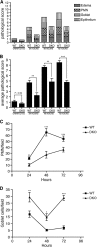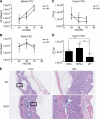Nod1 and Nod2 regulation of inflammation in the Salmonella colitis model
- PMID: 20921147
- PMCID: PMC2981303
- DOI: 10.1128/IAI.00759-10
Nod1 and Nod2 regulation of inflammation in the Salmonella colitis model
Abstract
The pattern recognition molecules Nod1 and Nod2 play important roles in intestinal homeostasis; however, how these proteins impact on the development of inflammation during bacterial colitis has not been examined. In the streptomycin-treated mouse model of Salmonella colitis, we found that mice deficient for both Nod1 and Nod2 had attenuated inflammatory pathology, reduced levels of inflammatory cytokines, and increased colonization of the mucosal tissue. Nod1 and Nod2 from both hematopoietic and nonhematopoietic sources contributed to the pathology, and all phenotypes were recapitulated in mice deficient for the signaling adaptor protein Rip2. However, the influence of Rip2 was strictly dependent on infection conditions that favored expression of the Salmonella pathogenicity island 2 (SPI-2) type III secretion system (TTSS), as Rip2 was dispensable for inflammation when mice were infected with bacteria grown under conditions that promoted expression of the SPI-1 TTSS. Thus, Nod1 and Nod2 can modulate inflammation and mediate efficient clearance of bacteria from the mucosal tissue during Salmonella colitis, but their role is dependent on the expression of the SPI-2 TTSS.
Figures





Similar articles
-
Salmonella enterica serovar Typhimurium ΔmsbB triggers exacerbated inflammation in Nod2 deficient mice.PLoS One. 2014 Nov 25;9(11):e113645. doi: 10.1371/journal.pone.0113645. eCollection 2014. PLoS One. 2014. PMID: 25423082 Free PMC article.
-
Commensal and probiotic bacteria influence intestinal barrier function and susceptibility to colitis in Nod1-/-; Nod2-/- mice.Inflamm Bowel Dis. 2012 Aug;18(8):1434-46. doi: 10.1002/ibd.22848. Epub 2011 Dec 11. Inflamm Bowel Dis. 2012. PMID: 22162005
-
The Salmonella pathogenicity island (SPI)-2 and SPI-1 type III secretion systems allow Salmonella serovar typhimurium to trigger colitis via MyD88-dependent and MyD88-independent mechanisms.J Immunol. 2005 Feb 1;174(3):1675-85. doi: 10.4049/jimmunol.174.3.1675. J Immunol. 2005. PMID: 15661931
-
Nod-like receptors in the control of intestinal inflammation.Curr Opin Immunol. 2012 Aug;24(4):398-404. doi: 10.1016/j.coi.2012.04.010. Epub 2012 Jun 5. Curr Opin Immunol. 2012. PMID: 22677577 Review.
-
NOD1 and NOD2: signaling, host defense, and inflammatory disease.Immunity. 2014 Dec 18;41(6):898-908. doi: 10.1016/j.immuni.2014.12.010. Epub 2014 Dec 6. Immunity. 2014. PMID: 25526305 Free PMC article. Review.
Cited by
-
RIP2 promotes FcγR-mediated reactive oxygen species production.J Biol Chem. 2019 Jun 28;294(26):10365-10378. doi: 10.1074/jbc.RA118.007218. Epub 2019 May 21. J Biol Chem. 2019. PMID: 31113864 Free PMC article.
-
Role of inflammasomes in salmonella infection.Front Microbiol. 2011 Jan 31;2:8. doi: 10.3389/fmicb.2011.00008. eCollection 2011. Front Microbiol. 2011. PMID: 21687405 Free PMC article.
-
The role of bacteria and pattern-recognition receptors in Crohn's disease.Nat Rev Gastroenterol Hepatol. 2011 Mar;8(3):152-68. doi: 10.1038/nrgastro.2011.3. Epub 2011 Feb 8. Nat Rev Gastroenterol Hepatol. 2011. PMID: 21304476 Review.
-
Salmonella enterica serovar Typhimurium ΔmsbB triggers exacerbated inflammation in Nod2 deficient mice.PLoS One. 2014 Nov 25;9(11):e113645. doi: 10.1371/journal.pone.0113645. eCollection 2014. PLoS One. 2014. PMID: 25423082 Free PMC article.
-
A Potential Role of Salmonella Infection in the Onset of Inflammatory Bowel Diseases.Front Immunol. 2017 Feb 28;8:191. doi: 10.3389/fimmu.2017.00191. eCollection 2017. Front Immunol. 2017. PMID: 28293241 Free PMC article. Review.
References
-
- Barthel, M., S. Hapfelmeier, L. Quintanilla-Martinez, M. Kremer, M. Rohde, M. Hogardt, K. Pfeffer, H. Russmann, and W. D. Hardt. 2003. Pretreatment of mice with streptomycin provides a Salmonella enterica serovar Typhimurium colitis model that allows analysis of both pathogen and host. Infect. Immun. 71:2839-2858. - PMC - PubMed
-
- Bonen, D. K., Y. Ogura, D. L. Nicolae, N. Inohara, L. Saab, T. Tanabe, F. F. Chen, S. J. Foster, R. H. Duerr, S. R. Brant, J. H. Cho, and G. Nunez. 2003. Crohn's disease-associated NOD2 variants share a signaling defect in response to lipopolysaccharide and peptidoglycan. Gastroenterology 124:140-146. - PubMed
-
- Carneiro, L. A., J. G. Magalhaes, I. Tattoli, D. J. Philpott, and L. H. Travassos. 2008. Nod-like proteins in inflammation and disease. J. Pathol. 214:136-148. - PubMed
-
- Chamaillard, M., M. Hashimoto, Y. Horie, J. Masumoto, S. Qiu, L. Saab, Y. Ogura, A. Kawasaki, K. Fukase, S. Kusumoto, M. A. Valvano, S. J. Foster, T. W. Mak, G. Nunez, and N. Inohara. 2003. An essential role for NOD1 in host recognition of bacterial peptidoglycan containing diaminopimelic acid. Nat. Immunol. 4:702-707. - PubMed
Publication types
MeSH terms
Substances
Grants and funding
LinkOut - more resources
Full Text Sources
Other Literature Sources
Molecular Biology Databases
Miscellaneous

